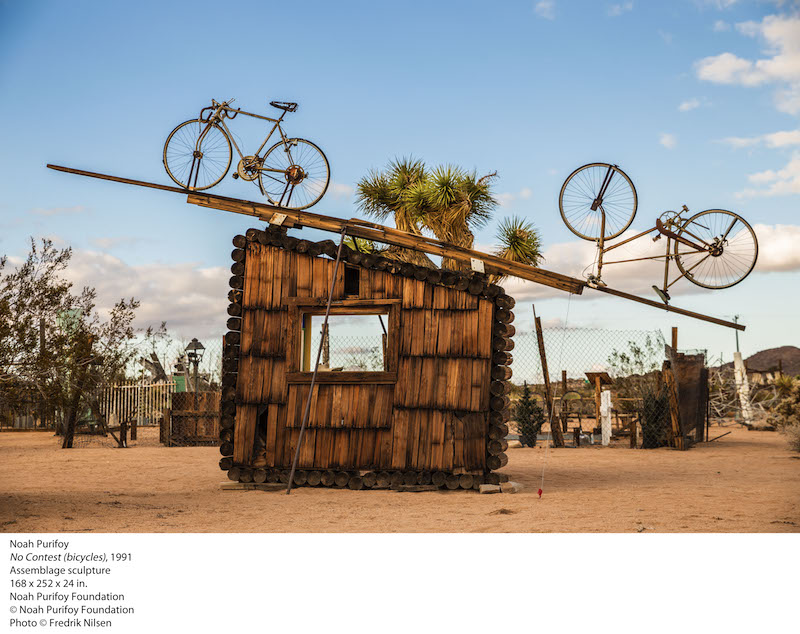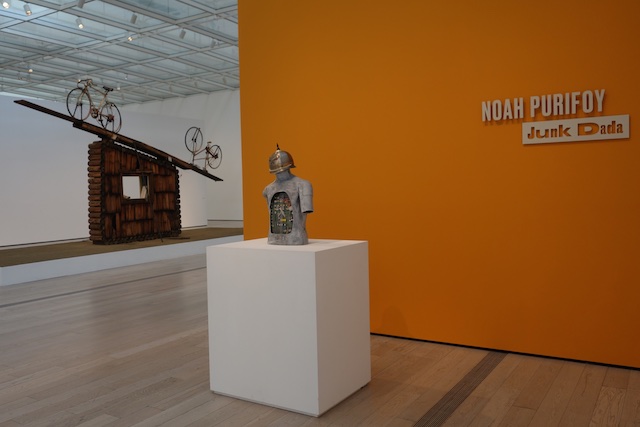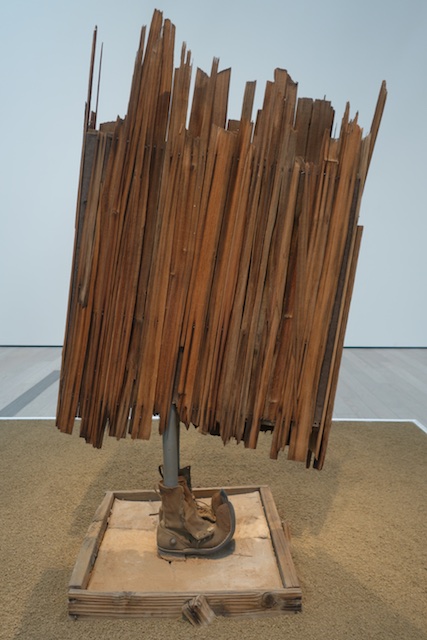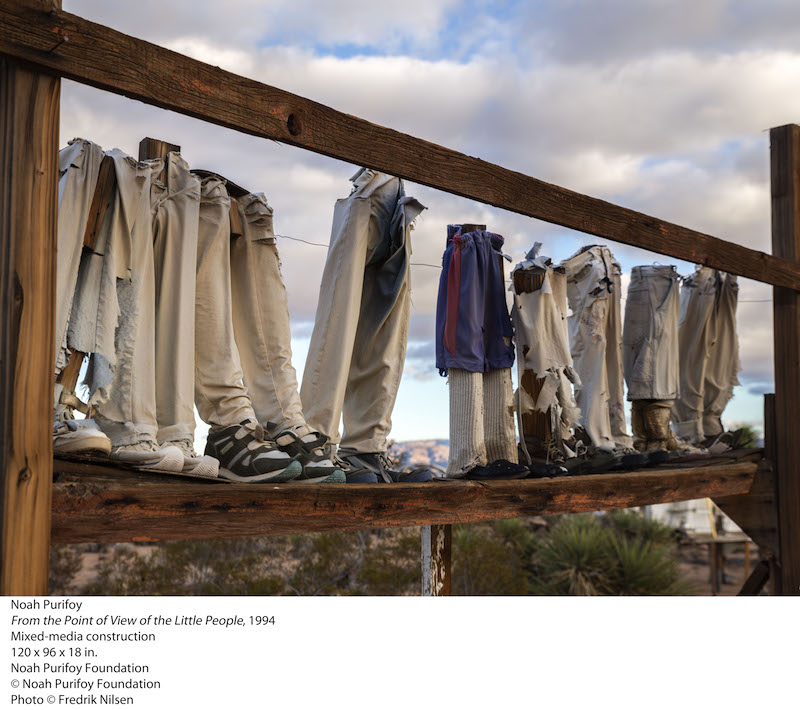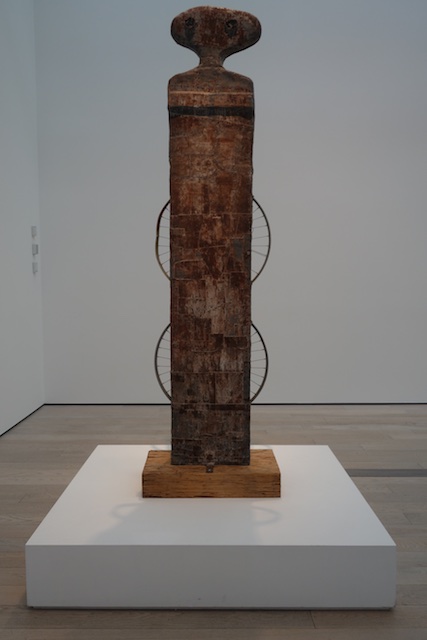Purifoy in the Desert
If you are intrepid enough to go off the beaten path to visit Noah Purifoy’s Outdoor Desert Art Museum in the High Desert—and you find it—you will probably be asking yourself a lot of questions. Just where am I? What is this place? Is it even open?
Answers to the first and third question come easiest: you are technically in Joshua Tree and the Museum is probably open, though likely no one will be on hand to greet you at the entrance or take a ticket (there are none). And what, exactly, is this place? That requires a longer explanation.
In 1989 esteemed artist, activist, and educator Noah Purifoy moved to a remote parcel in this part of the Mojave Desert where he lived for the last fifteen years of his life, creating a rambling collection of large-scale assemblage sculptures built from junked materials. Visitors can traverse the dusty 7.5-acre site to view—and sometimes enter—his curious constructions made from car doors, plywood, tires, broken mirrors, old clothes, and more. It’s a mind-boggling art park of decay and detritus, made even more surreal by the fact that it sits unprotected in the fierce desert climate. This is no accident. In fact, Purifoy was interested to watch as nature changed his works over time.
If you intend to visit, closed-toe shoes are advisable. Children will delight in exploring the property and the otherworldly sculptures that abound on it, but keep a close watch; the site is replete with rusting metal and other potential hazards.
LACMA's retrospective
If all of this sounds interesting but a little too far-flung and adventuresome, you’re in luck. This summer the Los Angeles County Museum of Art (LACMA) is presenting the exhibition Noah Purifoy: Junk Dada, the first monographic exhibition dedicated to Purifoy since his passing, and eight of the large-scale sculptures that normally reside in the desert have been transported to LACMA for the occasion. Since these pieces have been temporarily removed from the site where Purifoy intended them to live and be viewed, the museum has mounted them on large, sand-covered platforms as a cue to visitors that these works have come from Purifoy’s outdoor museum.
Noah Purifoy: Junk Dada examines the artist’s long career, starting with his pre-desert days when he created an important body of sculpture constructed out of the remnants of another sort of fierce landscape: charred debris from the 1965 Watts rebellion. The works—which toured from 1966–9 in 66 Signs of Neon, an exhibition organized by Purifoy and fellow artist Judson Powell that focused on the riots—marked an turning point for Purifoy, who dedicated himself to the found object and to using art as a tool for social change in the twenty years that followed the rebellion. (Now, fifty years later, Purifoy’s passion reverberates in the recent work of another acclaimed Los Angeles artist, Mark Bradford, who is showing several paintings at the Hammer Museum that refers to the 1992 uprisings in Los Angeles.)
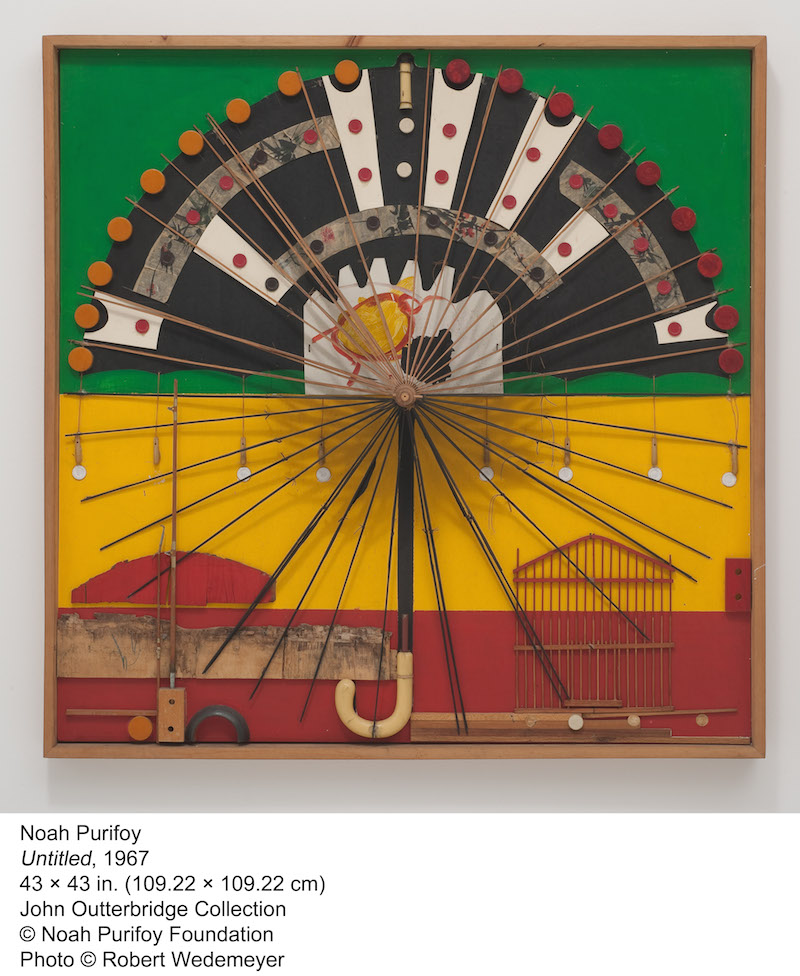
Purifoy_Unknown_1967
66 Signs of Neon is represented through approximately a dozen assemblage works by Purifoy and other artists including Powell, Debby Brewer, and Arthur Secunda. Also on display is a selection of printed images from Purifoy’s 1971 solo exhibition at the now-defunct Brockman Gallery in Leimert Park, the African American cultural hub where not coincidentally Bradford retains a studio and recently opened the hybrid art/social services space, Art + Practice. Soon after his gallery show, Purifoy withdrew from making art for more than a decade to concentrate his energies on social work and art advocacy via the California Arts Council.
In 1988 he returned with gusto to his art practice, completing numerous wall works and freestanding assemblages that are some of the most engaging pieces in the exhibition. Children and adults alike will enjoy studying these colorful constructions and identifying the everyday items—like shoes, hairbrushes, tennis rackets, picture frames, and table legs—that come together in powerful compositions that beg discussions ranging from consumerism to race to nostalgia.
Purifoy was born in 1917 in Snow Hill, Alabama and raised in Birmingham. He grew up in the segregated South, fifty years before the effects of civil rights were tangible. During World War II, he served in the South Pacific in the military as part of the US Navy’s Construction Battalion (Seabees). Following the war, Purifoy earned a master’s degree in social work in 1949 from Atlanta University in Georgia. In 1951 he enrolled in the prestigious Chouinard Art Institute (now known as Cal Arts), where he was one of the first African American students. Purifoy went on to become an indelible part of the Watts community as a founding director of the Watts Towers Arts Center. There he used art as a tool to inspire others and created art programs for underserved children, among numerous accomplishments. He died in 2004.
LACMA is open Monday, Tuesday, and Thursday: 11 am–5 pm; Friday: 11 am–8 pm; Saturday and Sunday: 10 am–7 pm; and closed Wednesday. Admission is $15 for adults, $10 for seniors and students, and free for children 17 and under, members, and active-duty military personnel and their families. LA County residents receive free admission after 3 pm every weekday LACMA is open.
Noah Purifoy’s Outdoor Desert Art Museum
Joshua Tree
Directions: From 29 Palms Highway drive north on Sunburst. Follow the paved road as it turns right and then turns left and becomes Border Avenue. Turn right on Aberdeen Drive onto a dirt road. Turn left on Center Avenue and then right again almost immediately on Blair Lane.
For more on the parallels between Noah Purifoy and Mark Bradford, see this recent article from KCET Arbound.
Written by Stacey Ravel Abarbanel

